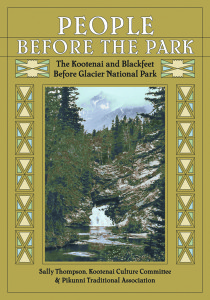
Before the Crown of the Continent was a national park, it was a homeland to the Kootenai and the Blackfeet peoples. In People Before the Park, The Kootenai and Blackfeet Before Glacier National Park, a new release from the Montana Historical Society Press, these tribes share their traditions – stories and legends, foodways and hunting techniques, games and spiritual beliefs. The book is a collaboration between Missoula author and anthropologist Sally Thompson, the Kootenai Culture Committee, and the Pikunni Traditional Association.
The Kootenai and Blackfeet knew how to make a home in the mountains. They knew where to find reliable root crops and berries, potable water and rich fields of grass to sustain their tired horses after a journey across the mountains. They knew what to expect as the seasons unfolded, year after year. In People Before the Park, they share their knowledge.
The Kootenai lifestyle, before the reservation era, was migratory but far from random. The journey to a new camp location was more than a means to an end. Food and medicine were gathered along the way, and important places along the trails were revisited. Stick games, horse racing, and storytelling contributed to the wealth of daily life. The Blackfeet world is defined by a sequence of ceremonies, bundle openings, and the Medicine Lodge, the Okan. In the Blackfeet world, people knew where they were in the great cosmos by carefully observing natural patterns. In the days when buffalo still roamed the land, they knew when to travel, and where different foods would be ready.
Each location was known for the resources it held, whether plant, animal, or mineral, and year after year, Blackfeet people returned to these locations. By the end of the 19th century, when the tribes were confined to reservations, this way of life slowly came to an end. The people have not forgotten what they were taught at the beginning of time. The elders still tell of the days when the tribes made their seasonal rounds, and share these stories in People Before the Park.
For more information, visit Montana Historical Society Press.